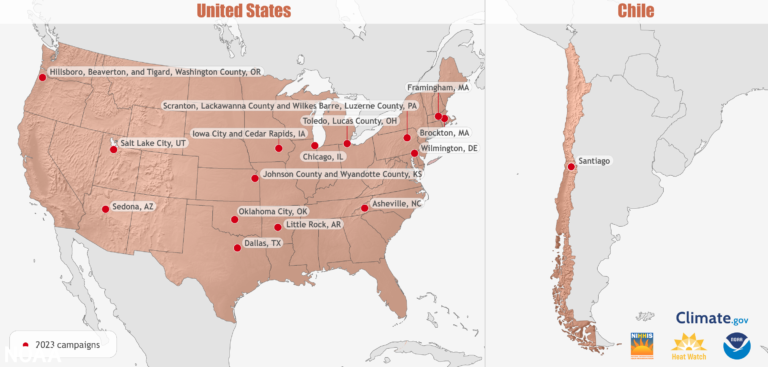NOAA’s Urban Heat Island (UHI) mapping campaign will take place in 18 communities across 14 states and in one international city this summer.
Now in its seventh year, the UHI mapping campaign helps local decision-makers take actions to reduce the health impacts of extreme heat, which often target the most vulnerable.
Rick Spinrad, NOAA Administrator, said, “The burden of heat is not shared equally in our urban areas. Gathering this type of environmental intelligence helps communities measure their hottest places so they can develop strategies to reduce the dangerous effects of heat. Community by community, we’re working to create a Climate-Ready Nation that is resilient in a changing world.”
Communities chosen for the 2023 program are: Chicago; Salt Lake City; Dallas; Oklahoma City; Asheville, North Carolina; Framingham and Brockton, Massachusetts; Johnson County and Wyandotte County, Kansas, which includes the Kansas City suburbs; Wilmington, Delaware; Toledo, Ohio; Little Rock, Arkansas; Scranton and Wilkes-Barre, Pennsylvania; Sedona, Arizona; Iowa City and Cedar Rapids, Iowa; and Washington County, Oregon, outside of Portland.
In addition, NOAA is working with local groups and the Pan-American Health Organization on an international heat island mapping campaign in Santiago, Chile. This will be the third NOAA-funded international campaign. Campaigns were completed in Freetown, Sierra Leone and Rio de Janeiro, Brazil earlier this year.
Since 2017, NOAA, through the interagency National Integrated Heat Health Information System (NIHHIS), has funded CAPA Strategies to provide science support for more than 70 community-led urban heat island mapping campaigns. Led by a team of local partners in each city, volunteer citizen scientists will travel through their neighborhoods in the morning, afternoon and evening on one of the hottest days of the year with heat sensors mounted on their own cars or bikes. The sensors record temperature, humidity, time and the volunteers’ location every second. CAPA’s end-to-end program, including sensor technology, analysis, modeling and community engagement, allows communities to develop hyper-local descriptions of heat and strategize mitigation options specific to each community and its needs.
During the 2022 urban heat island campaigns, 782 citizen scientists collected over one million measurements in 15 US communities.
Cities from past campaigns have used their heat island maps to implement tree planting strategies, inform communities of the location of new public transit shelters for cooling relief, develop heat action plans, educate residents and policymakers and inform new research. The data from the UHI campaigns are open access and available on the federal website Heat.gov.



